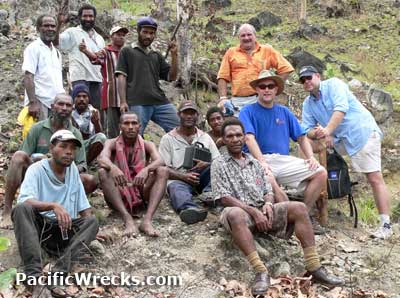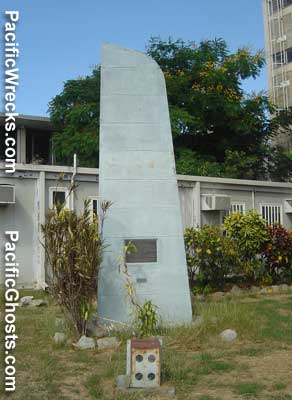Schwimmer Drome (14 Mile)
Last weekend, Mike Claringbould, Keith Hopper and myself, with lots of local support headed off for a Saturday morning hike. Our trip took us firstly to the end of Schwimmer Drome (14 Mile), one of the wartime Port Moresby strips. This strip is abandoned now and overgrown with kunai grass, and a few gum trees.
 Squatters at the end of the strip are excavating an old WWII dump, looking for aluminum to sell to the local scrapper. They had turned up a few U.S. Army Dog Tags, and what appeared to be human remains buried in the dump. So we went to see what we could see. The bones are a mystery so far with plenty of theories. We toured a portion of the old Drome, finding concrete hardstands, discarded drums and old truck carcases. After that, we headed of up the valley to look for one of two wrecks that the locals knew about.
Squatters at the end of the strip are excavating an old WWII dump, looking for aluminum to sell to the local scrapper. They had turned up a few U.S. Army Dog Tags, and what appeared to be human remains buried in the dump. So we went to see what we could see. The bones are a mystery so far with plenty of theories. We toured a portion of the old Drome, finding concrete hardstands, discarded drums and old truck carcases. After that, we headed of up the valley to look for one of two wrecks that the locals knew about.
A Famous P-40 Wreck
 A 4WD trip and then a short steep hike up a hill side took us to the very sad remains of P-40E Kittyhawk A29-9. This plane had gone more or less vertically into the hillside and all that remained, some sixty years on, was a shattered engine, some armor plating, and portions of broken landing gear. There was a large hole in the hillside where impact had occurred. The remains had been dug out of the pit at the time of the crash and time has scattered them down the hillside.
A 4WD trip and then a short steep hike up a hill side took us to the very sad remains of P-40E Kittyhawk A29-9. This plane had gone more or less vertically into the hillside and all that remained, some sixty years on, was a shattered engine, some armor plating, and portions of broken landing gear. There was a large hole in the hillside where impact had occurred. The remains had been dug out of the pit at the time of the crash and time has scattered them down the hillside.
 We knew immediately [as WWII history buffs], that were were looking at the remains of RAAF 75 Squadron P-40E Kittyhawk A29-8 piloted by S/Ldr. John Jackson. He was shot down on April 28, 1942 towards the end of a posting to Port Moresby by the first fighter squadron sent to New Guinea. This first RAAF Squadron had only limited air battle success, but they did draw vital blood from the Japanese Navy, leading to losses of very skilled Japanese pilots that were hard to replace.
We knew immediately [as WWII history buffs], that were were looking at the remains of RAAF 75 Squadron P-40E Kittyhawk A29-8 piloted by S/Ldr. John Jackson. He was shot down on April 28, 1942 towards the end of a posting to Port Moresby by the first fighter squadron sent to New Guinea. This first RAAF Squadron had only limited air battle success, but they did draw vital blood from the Japanese Navy, leading to losses of very skilled Japanese pilots that were hard to replace.
 75 sq was replaced by the American Army Air Force, who initially fared no better. Those were desperate days indeed. Jackson is a famous name in PNG as the main international airport is named after him. His wreck site is hard to find and I know only of two other visits in post war years by wandering expats. I am sure that I will return shortly to this site, which properly seems to reflect the violence and death of a wartime aviator, better known than others of his brotherhood.
75 sq was replaced by the American Army Air Force, who initially fared no better. Those were desperate days indeed. Jackson is a famous name in PNG as the main international airport is named after him. His wreck site is hard to find and I know only of two other visits in post war years by wandering expats. I am sure that I will return shortly to this site, which properly seems to reflect the violence and death of a wartime aviator, better known than others of his brotherhood.
Em Tasol
John Douglas
Seeking Support
John Douglas writes WWII wreck related
new briefs for Pacific Wreck Database from his home in Port Moresby.
Learn how to help Douglas' efforts and Wreck 'Tec network, donate
your old 35mm camera, video equipment or financial help - support
this effort!
Return to John Douglas Main
Page